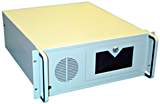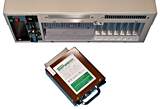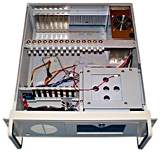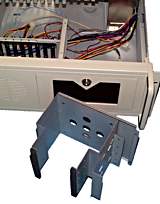
Topower TP-1945 19" rack mount PC case
Review date: 12 April 1999. Last modified 03-Dec-2011.
The serious computers at big companies and Internet Service Providers and other places that run lots and lots of machines in parallel are usually not mounted in conventional, standalone, tower or desktop cases. They're bolted into 19" racks. The 19" rack is a standard format for all sorts of high-tech gear, from PA equipment to scientific instruments, and you can get 19" cases for PCs too. Rack-mount cases are used when you want the most equipment with the least footprint (there's nothing stopping you buying a rack that reaches all the way to the ceiling), and typically provide considerably more protection to the equipment inside than ordinary cases.
Topower's TP-1945 is a rack-mount case for computer gear, including but not limited to regular AT and ATX PC motherboards - it can also take a passive backplane board. With a filtered fan, a locking door over its drive bays and rubber-cushioned hold-downs for expansion cards, it's suitable for fairly hostile environments, such as factory-floor use.

The lockable front panel provides reasonable security.
If you need real security, many lockable racks are available with honest-to-goodness
quality locks, and much more solid construction than the equipment they
contain.

With the door open, you can slide out the fan dust
filter for cleaning.
The TP-1945 offers three 3.5" and two 5.25" drive bays. Both of the 5.25" bays and one of the 3.5" bays have front panel cutouts, under the hinging door, and can therefore be used for removable media. When the door is open, you can also get at the reset and keyboard lock switches.
The case I checked out had twin redundant 250 watt Power Supply Units (PSUs) fitted. A version with dual 300 watt supplies is also available. If one PSU fails, you can yank it out without turning the system off, and replace it on the fly. Redundant power supplies are essential for equipment that has to be on all of the time, and they account for a large slice of the TP-1945's price - something like $1600 retail (Australian dollars; ex tax dealer price around $1050). As I note in the review of Topower's TP-1400 server case here, twin redundant power supplies cost something like ten times as much as a single ordinary PSU with half of their combined wattage.

Except for the dual power supplies, the back panel
could pass for an ordinary desktop case.
Vital statistics
The TP-1945 is unsurprisingly, 19 inches wide, by 20 inches deep and 7 inches high (483mm by 500mm by 177mm). This makes it a "four unit" rack case (the smallest rack-mount devices are "one unit" and have a height of 44mm). There's a sturdy handle on either side of the front panel, as is normal for rack-mount gear, and the case is fairly portable; empty, with the power supplies installed, it weighs 20 kilograms (45 pounds). It's made from 1mm mild steel, and painted the usual beige colour.
You also get the usual little box of extra bits, including motherboard and drive mounting screws and spacers, blank panels for covering unused drive bays, back panel inserts for different kinds of motherboard, four stick-on rubber feet and a couple of keys. These are a step up from the awful stamped-metal keys which operate the comedy locks on super-cheap computer gear, but anybody with a flathead screwdriver could still pop the TP-1945's front door open in seconds. This is not a serious problem, though; if you need real security, you can get 19 inch racks that provide it, via a proper locking door over the entire contents.
To get into the case, you remove four screws and lift off the top panel. Inside, there's the usual collection of switch and LED leads, all labelled except for the power switch.
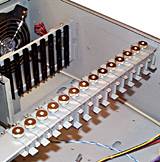
These are the 14 rubber-cushioned hold-down clamps
for expansion cards. They're retained with simple finger-tighten nuts, and
keep cards secure whether you've installed an ordinary PC motherboard or
a passive backplane.
The motherboard mounting area is much the same as in any ordinary PC case, except for the expansion card hold-down bar over the top, whose rubber-padded clamps will keep cards in their slots in extreme conditions.

A hefty 120mm 12 volt fan keeps the air flowing
through the case. A standard 80mm fan on top of the power supply cradle
helps to pull air out of the case at the back. Note the pre-installed guides
for the ends of full-length PC expansion cards in front of the fan.
Problems
The TP-1945's chief drawbacks are the same as those for its Topower cousin, the hefty TP-1400 server case (reviewed here). For a start, it comes with no manual. Not even an exploded diagram. Computing experts will know exactly how to set the case up, and even a novice won't find it the puzzle of the century, but it's nonetheless a bit much to pay more than a thousand bucks and get no documentation.
Also like the TP-1400, the TP-1945 has sharp stamped metal edges inside, just like the dodgiest little mini-tower case you'll ever see. The TP-1400 has the easy-access design of all such monster server cases, so most users won't have to brush up against its sharp edges, but a rack case is more tightly laid out. It's unreasonable to say that the sharp edges are really dangerous - I've had paper cuts as bad as anything a lousy computer case has ever inflicted on me - but they're certainly annoying, and not something we should have to put up with in an expensive piece of hardware.
Aside from that, I only found one significant problem with the TP-1945. To mount drives in it, you have to remove the drive bay cradle. The cradle is held in place with four screws. The two screws which threaded into a bracket spot-welded to the side of the case were incredibly tight - they turned, but only protestingly, and didn't get any easier to turn as I backed them out. I can only assume that the screws have been forced into a too-small hole; their resistance was such that the apparently under-strength spot-weld at the rear of the side bracket popped loose as I removed the screw nearest it. The other spot-weld held, but I don't know if it'd last if the bays were removed and replaced more than a couple of times.
Fortunately, the screws are fairly good, and could at least be removed. The ultra-cheap screws that come with budget-priced cases are often so poorly made that applying too much torque to them twists the head clean off, which often leaves you with an annoying screw-stub locking the parts together.
Overall
This case isn't perfect, and it's certainly not for everyone, but it'll do the job and, for what it is, it's quite well priced. The lack of a manual and the sharp metal are let-downs but not terrible ones, and the over-tight mounting screws might just be an oddity of the one case I checked out. If you're in the market for a flexible four unit PC rack case, the Topower TP-1945 is a definite contender.
